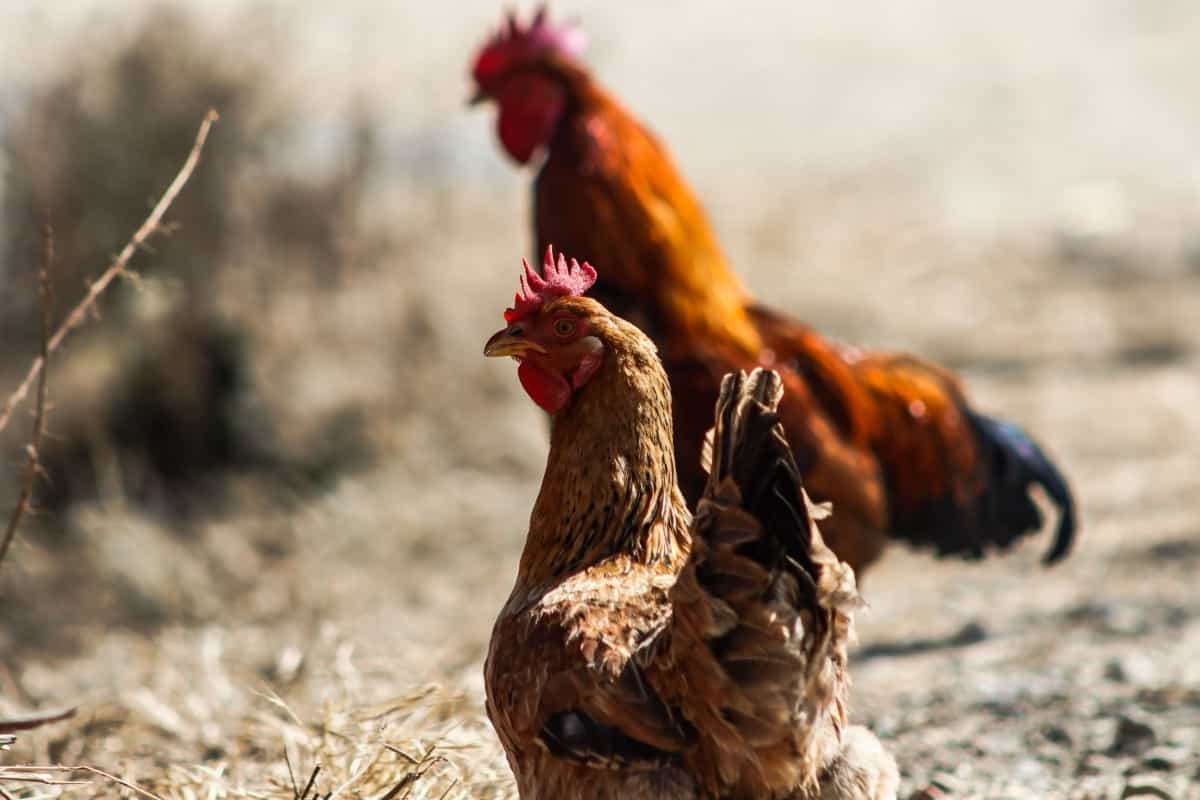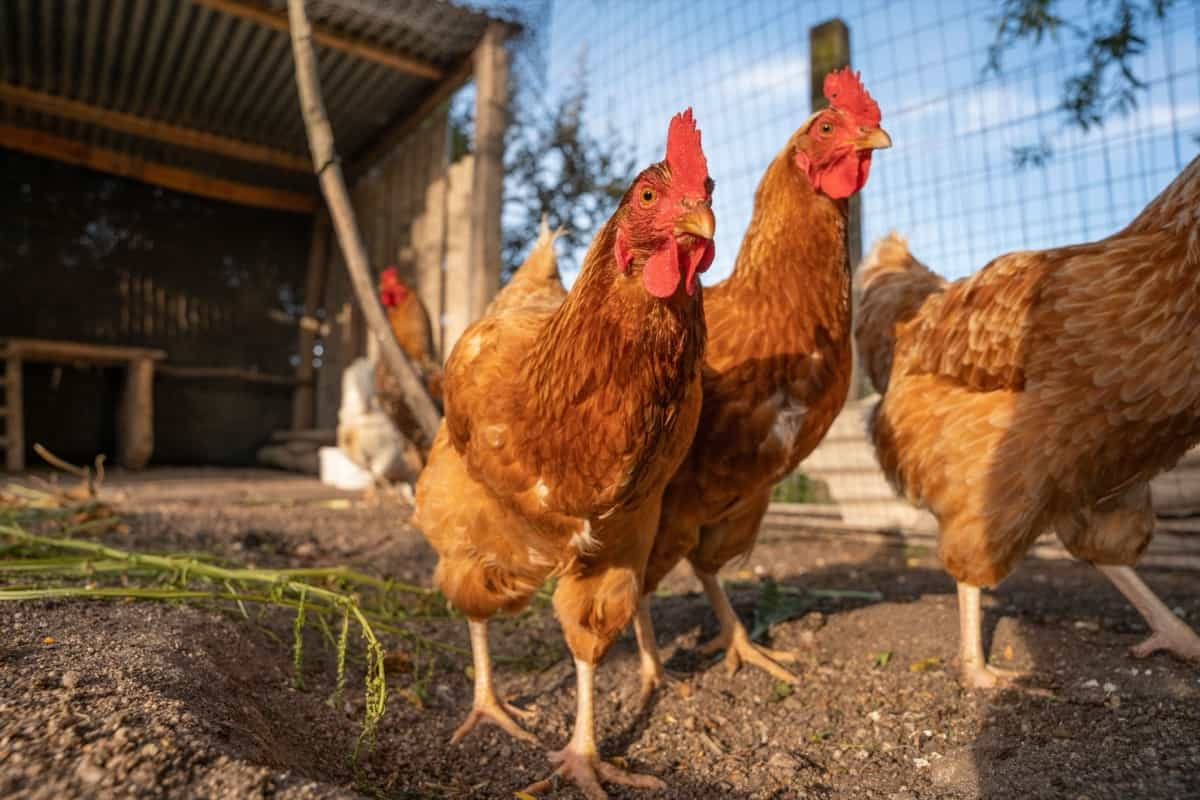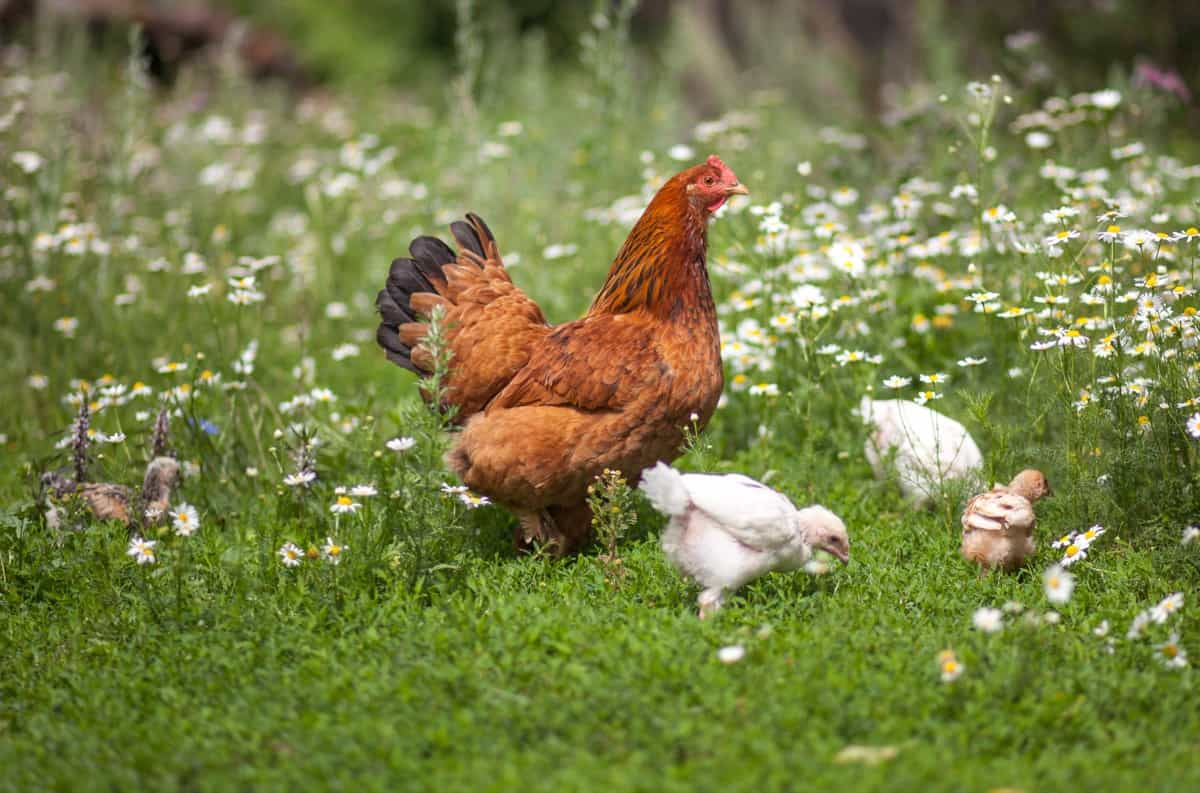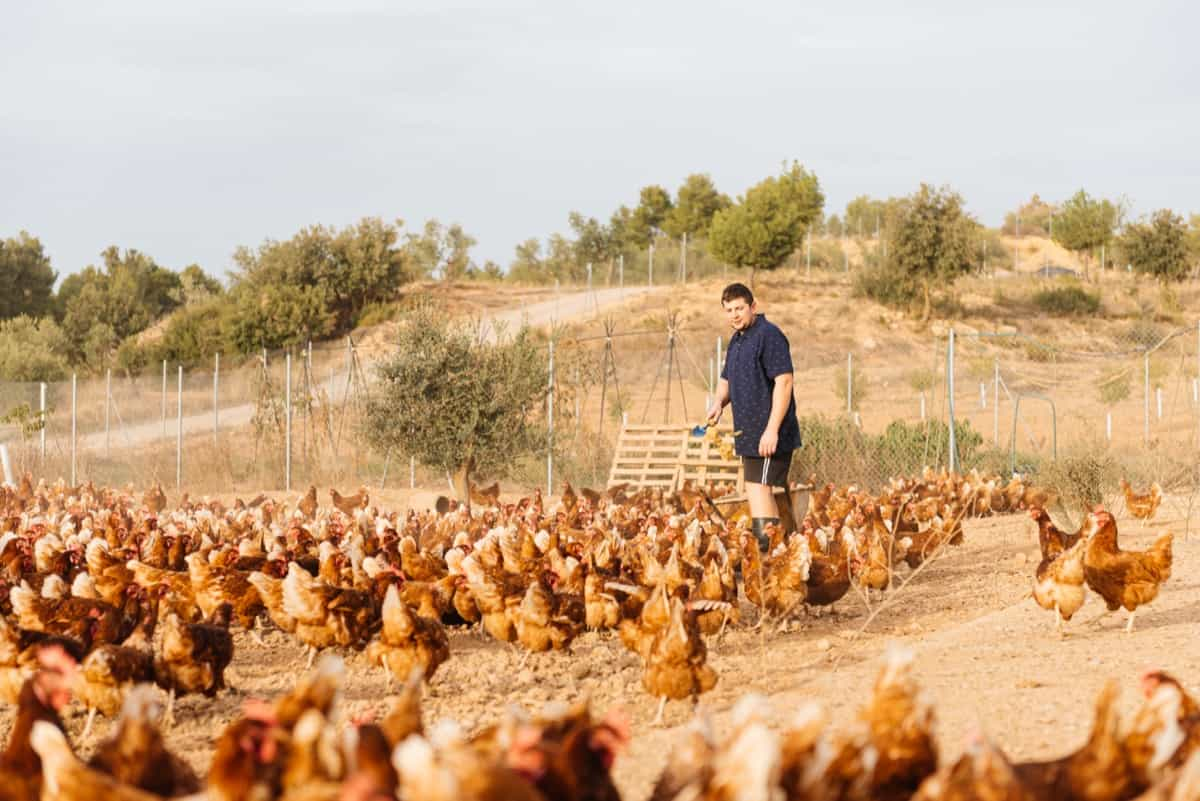The Vanaraja chicken breed is a popular dual-purpose breed known for its superior egg and meat production capabilities. It was developed by ICAR (Indian Council of Agricultural Research). Vanaraja is renowned for its high-quality meat and eggs, making it a valuable asset for both commercial and subsistence farming ventures.

Role of Vanaraja Chicken in Mixed Farming Systems
Their ability to thrive in free-range conditions makes them suitable for integration with crop farming, where they help in pest control and nutrient recycling. Additionally, their dual-purpose nature allows farmers to derive both meat and eggs from the same flock, optimizing resource utilization and diversifying income streams.
Vanaraja Chicken Breed History and Background
Origin and Development
Vanaraja chicken originated in India through selective breeding programs aimed at developing a dual-purpose breed suitable for both meat and egg production. The breed is a cross between Rhode Island Red and Indigenous Aseel chickens, combining the desirable traits of both parent breeds.
Breeding Institutions and Objectives
The development of Vanaraja chicken involved collaboration between various agricultural research institutions, universities, and poultry breeding centers in India. The breeding objectives focused on creating a hardy and productive breed capable of thriving in the diverse agro-climatic conditions prevalent in the country.
Vanaraja Breed Characteristics
Physical Description
Vanaraja chickens typically exhibit a medium-sized frame with well-developed musculature, making them suitable for both meat and egg production. They have a sturdy body build with a broad chest, straight back, and strong legs. The comb is usually single and moderately large, while the wattles are of medium size. The beak is stout, and the eyes are alert and bright.
Size, Feathering, and Color Patterns
Adult Vanaraja chickens generally weigh between 2 to 2.5 kilograms for males and 1.5 to 2 kilograms for females. Their feathering is dense and close-fitting, providing adequate insulation against varying climatic conditions. The color patterns may vary, but they commonly exhibit a combination of red, brown, and black plumage, reflecting their Rhode Island Red ancestry.
Behavioral Traits
Vanaraja chickens are known for their active and foraging behavior. They thrive in free-range environments where they can explore and scavenge for food. Despite their active nature, they are relatively calm and docile, making them suitable for backyard and small-scale poultry farming operations.
In case you missed it: Ultimate Guide to Cuckoo Marans Chicken: Facts, Egg Production, Raising, Care, Price, and Lifespan

Temperament and Social Structure
Vanaraja chickens display a hierarchical social structure within their flocks. They establish a pecking order where dominant individuals assert their authority over subordinate ones. Despite occasional squabbles, they generally coexist peacefully within the flock. Vanaraja chickens also exhibit strong maternal instincts, with hens being attentive mothers to their chicks.
Vanaraja Genetic Diversity
Genetic Composition and Selection
Vanaraja chicken is a result of selective breeding programs aimed at combining the desirable traits of its parent breeds, the Rhode Island Red and the Indigenous Aseel chicken. Through controlled mating and rigorous selection processes, breeders focused on enhancing traits such as rapid growth, high feed conversion efficiency, disease resistance, and adaptability to diverse environmental conditions.
Adaptability to Environments
They thrive in rural and urban settings and are well-suited to free-range and backyard poultry farming systems. Their ability to withstand heat stress and adapt to different climatic conditions makes them popular among poultry farmers in regions with tropical and subtropical climates. Additionally, their robust constitution and resistance to common poultry diseases further contribute to their adaptability.
Production Qualities
Egg-Laying Performance: Vanaraja Egg Production
Vanaraja chickens are recognized for their excellent egg-laying capabilities. On average, hens can lay approximately 180 to 200 eggs per year under optimal management conditions. The egg production rate tends to be consistent throughout the laying cycle, with hens displaying good persistence in their laying behavior.
Egg Size, Color, and Production Rate
Vanaraja chicken eggs are typically medium to large, with a weight ranging from 55 to 60 grams per egg. The eggshell color may vary, but they commonly exhibit shades of brown or light tan. Vanaraja hens demonstrate good shell quality, with sturdy shells that can withstand handling and transportation.
Vanaraja Meat Quality
They are known for their tender meat, making them popular choices for meat production in addition to egg-laying. Vanaraja chickens reach marketable weights within a relatively short period, typically around 12 to 14 weeks for broilers.
Growth Rates and Feed Efficiency
Broiler Vanaraja chickens achieve marketable weights quickly, with average daily weight gains ranging from 45 to 50 grams per day. They efficiently convert feed into muscle mass, resulting in high feed conversion ratios. Additionally, Vanaraja chickens are known for their ability to thrive on various feed sources, including locally available grains and forage.
Nutritional Needs of Vanaraja
Vanaraja Chicken Feeding Practices for Optimal Health
A diet high in protein is essential, especially for chicks and growing birds, to support muscle development and overall growth. Additionally, adequate levels of vitamins, minerals, and essential fatty acids are necessary for health and immune function. Feeding practices should include providing access to clean, fresh water at all times, as water is essential for digestion, nutrient absorption, and temperature regulation.
In case you missed it: Ultimate Guide to Ermellinata di Rovigo Chicken: Breed Overview, Raising, and Care

Vitamins, Minerals, and Water
Vitamin A for vision and immune function, while vitamin D promotes calcium absorption and good bone health. Vitamin B for energy metabolism and nerve function, while vitamin E promotes immune function. Minerals such as calcium, phosphorus, and magnesium are crucial for bone development and muscle function. Providing access to clean, fresh water is vital for hydration and maintaining overall health.
Vanaraja Health Management
Common Health Issues
Vanaraja chickens are generally robust and resilient but still susceptible to some health issues. Common health problems include respiratory infections, parasitic infestations (such as coccidiosis and worms), nutritional deficiencies, and injuries. Proper hygiene, balanced nutrition, and regular health monitoring can help prevent many health issues.
Preventative Vanaraja Chicken Care and Vaccinations
Preventative care includes implementing biosecurity measures to prevent the introduction and spread of diseases, providing a clean and comfortable living environment, and practicing good hygiene practices. Vanaraja chickens may require vaccinations against common poultry diseases such as Newcastle disease, infectious bronchitis, and Marek’s disease.
Housing and Care
Suitable Housing for Vanaraja Chickens
The housing structure should be well-ventilated to ensure good air quality and minimize the buildup of moisture and ammonia fumes, which can lead to respiratory problems. The housing should be easy to maintain to promote good hygiene and control the spread of diseases.
Design and Space Allocation
As a general guideline, provide at least 2-3 square feet of space per bird in the coop and ample space in the outdoor run for free-ranging. Nesting boxes should be provided for egg-laying hens, and perches or roosts should be installed to allow birds to rest off the ground at night.
Climate Adaptations
In hot climates, provide shade and ventilation to prevent heat stress, such as installing fans or misting systems and ensuring adequate airflow. In cold climates, provide insulation and heating as needed to maintain comfortable temperatures and prevent frostbite. Additionally, consider the orientation of the housing structure to maximize natural sunlight exposure while providing shelter from harsh weather elements.
Rearing Practices
Brooding and Early Life Care
During the brooding stage, provide a warm and draft-free environment with temperatures maintained around 32-35°C for the first week and gradually reduced after that. Use brooder lamps or heating pads to regulate temperature. Provide clean bedding, fresh water, and balanced chick starter feed. Monitor chicks for signs of stress, illness, or injury and provide prompt attention as needed.
Managing Mature Chickens
For mature Vanaraja chickens, ensure access to clean water and a balanced diet consisting of quality poultry feed. Provide suitable housing with ample space, proper ventilation, and protection from predators. Monitor flock health regularly and implement biosecurity measures to prevent disease transmission. Manage social dynamics within the flock to minimize aggression and maintain harmony. Regularly clean and maintain housing facilities to promote good hygiene.
In case you missed it: Gramapriya Chicken Farming: Characteristics, Uses, Egg Production, and Raising Facts

Conclusion
Known for their dual-purpose nature, robust characteristics, and adaptability, raising Vanaraja chickens plays a significant role in both meat and egg production. With their resilient nature and suitability for diverse farming systems, Vanaraja chickens continue to thrive in various agricultural landscapes.
- Ultimate Guide to Ossabaw Island Hog: Breeding, Raising, Diet, and Care
- Ultimate Guide to Juliana Pig: Raising Facts, Size, Diet, Care, and Lifespan
- Raising Lleyn Sheep: Disadvantages, Price, Uses, Characteristics, and Care
- Ultimate Guide to Meishan Pig: Breed Facts, Breeding, Raising, and Care
- Ultimate Guide to Teacup Pigs: Raising, Diet, Lifespan, Cost, and Care
- Guide to Raising Poll Dorset Sheep: Facts, Profile, Characteristics, Uses, and Care
- Ultimate Guide to Bighorn Sheep: Characteristics, Diet, Lifespan, Breeding, and Lifecycle
- Ultimate Guide to Raising Katahdin Sheep: Farming Facts, Breed Profile, Uses, and Care
- Ultimate Guide to Raising Oreo Cows: Belted Galloways Farming Facts, Profile, Uses, and Care